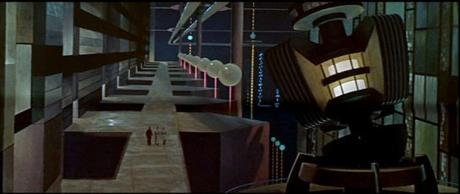 Scene from MGM’s Forbidden Planet (1956) – the Big Machine
Scene from MGM’s Forbidden Planet (1956) – the Big MachineComplications, Complications — Always Complications
It is night at United Planets Space Cruiser C-57D’s base camp. Wary crewmen Strong (James Drury) and Grey (Bob Dix) hear the sound of heavy breathing around them. Slipping by the two sentries, the unseen threat surreptitiously boards the craft. Opening one of the heavy-duty hatches, the invisible being enters the communications area where, it is soon learned, the cruiser’s Klystron frequency monitor has sustained enough damage as to be inoperable.
The next day Commander Adams chews out the two crewmen who inadvertently allowed the menace to invade their ship. He even raises his voice at Youngerford (Jimmy Thompson), the poor fellow asleep in his bunk, for having had a dream. “A dream!” the incensed commander incredulously repeats. Yes, indeed, one that will eventually turn into a nightmare. Chief Quinn comes over to inform the commander that, if he skips breakfast, he can repair the frequency monitor in due course. Adams’ mood lightens at this jocular jibe.
Meanwhile, Lt. Jerry Farman is ordered to stay with the ship while Adams and Doc board the tractor for Morbius’ abode. Farman doesn’t take too kindly to being left behind (especially since he’s certain that Adams will pay a call on the attractive young Altaira), but he obeys his superior officer’s directive. Both Adams and Doc believe that Robby the Robot may have been behind the break in, although the artificial being’s presence was never reported. That leaves one other suspect to grill.
No sooner do the two officers ride off, when we cut to a shot of Robby playing housemaid. The robotic servant hits a meddling monkey with one of his laser beams, which drives the puny pest away. Upon their arrival, the skipper tells Ostrow to wait for Morbius in the living room while he goes to meet Altaira at the pond near the back of her home.
Altaira, or Alta for short, is swimming in something, but it isn’t your typical bathing gear. We can tell she’s wearing a skimpy see-through outfit, with just enough material to cover some strategic body parts. There was no way a major movie studio like MGM, in mid-20th-century America, could get away with having a woman swim in the raw. Again, there’s a mindless 1950s mentality to this sequence (call it false modesty) of an obviously “embarrassed” Commander Adams forced to deal with an attractive young lady in the altogether.
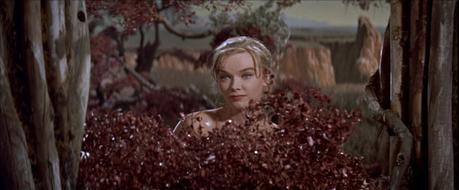
Thinking that she’s dressed only in her birthday suit, Adams is coy about his intrusion and evades looking directly at this vision of loveliness. Alta rises from the pond to get dressed behind a patently fake red-colored bush. Adams then takes advantage of the situation by apologizing for his brashness of the previous day. He turns around to find her in a ravishing white gown (the “virgin bride”) with a stunning emerald necklace wrapped about her neck.
Adams finally makes his move as they engage in a deeply satisfying embrace topped by prolonged kissing, certainly a more fulfilling encounter than the one Alta experienced with the overeager (and over-sexed) Lt. Farman.
Out of the blue, Adams and Alta are interrupted by the roar of a ferocious feline (a nice connection to MGM’s logo, Leo the Lion). Not to worry, it’s only her pet Bengal tiger, ready to pounce on the unsuspecting couple. Adams is forced to vaporize the leaping carnivore with his trusty blaster (with animation provided by Disney’s Joshua Meador). Alta is oblivious to the tiger’s reaction. She honestly has no idea why it was about to attack them. Adams takes her in his arms to protect her from further harm. He instinctively senses, as many in the viewing audience do, that the tiger saw him (and now her) as a threat to the peace and sanctity of its world.
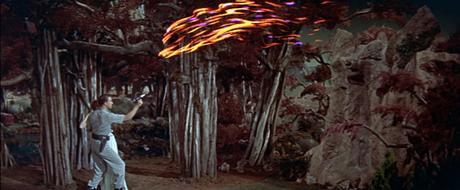
In the spring 1979 double issue of Cinéfantastique, devoted almost entirely to the making of Forbidden Planet, authors Frederick S. Clarke and Steve Rubin cite several sources for Irving Block and Allen Adler’s original story treatment (adapted by Cyril Hume for his screenplay). Among them is the legend of the guiltless damsel — in this instance, “the chaste and pure Altaira” who “enjoys an Edenic rapport with the transplanted Earth creatures who roam the lush, forested grounds of [her father’s] home, yet when she kisses Commander Adams for the first time, a change transpires in her relationship with the beasts and her pet tiger nearly kills her.”
This goes back to the fable of the maiden and the unicorn, “which states that only a pure virgin can tame a unicorn” — represented here by a savage tiger (or maybe, in the long run, by the Id monster itself!).
In the early going, when Adams, Ostrow and Farman first visit the Professor in the comfort of his home, the cagey Morbius claimed immunity from the destructive forces that once disrupted the tranquility of Altair-IV’s surface. Later on, Alta will claim to Adams the same impervious ability to the fiendish creature that still lurks about. Adams doesn’t believe her, and rightly so. For the simple reason that, from here on end, Alta has lost that golden glow of purity, no thanks to him.
Alien Nation
When he re-enters the house, Adams admits to Ostrow that he is quite taken with the girl. Who wouldn’t be in his position? Hmm, this complicates their assignment somewhat. After he and Doc are caught snooping around the professor’s study by the philologist himself, they report a sabotage of their communication equipment — with Morbius as their prime suspect.
Caught in his own maze of deceit and denial, Morbius finally comes clean about the Krell, the race of intellectually superior beings that once inhabited the planet two thousand centuries before man. He plays a sample of their music and shows the visitors an example of their construction, i.e. the characteristic doorway and arch. He also informs them that this “all but divine race perished in a single night” to causes still unknown.
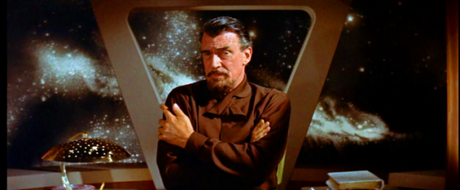
The Krell once visited the Earth, he tells them, and brought back many biological specimens, which clarifies the existence of the tiger, deer and monkey. But what were they like? “No record of their physical nature has survived,” Morbius comments, which is just as well. Better to imagine what the Krell might have been like than try to recreate the unimaginable.
This is one of the picture’s finest aspects, the fact that the screenwriters left it to the audience’s imagination to fill in the missing portions of the narrative. It also saved MGM studios some beaucoup bucks, since Morbius maintains that nothing of the Krell’s architecture or industry has survived on the planet’s surface. “Even their cloud-piercing towers of glass and porcelain and adamantine steel have crumbled back into the soil of Altair-IV and nothing, absolutely nothing remains above ground.”
Morbius takes the two officers inside one of the Krell laboratories (just one of their remaining artifacts), and introduces them to a teaching tool, the so-called “plastic educator,” a futuristic contraption once used to instruct their young (the atomic-age equivalent of “finger-painting,” so he tells them). Morbius delves into the incredible depth of knowledge the Krell had in their possession, which led to his tinkering together of a cultivated companion, Robby the gregarious Robot. He demonstrates the capabilities of the educator by creating a three-dimensional image of his daughter, “Aladdin’s lamp in a physics laboratory,” in Doc Ostrow’s words.
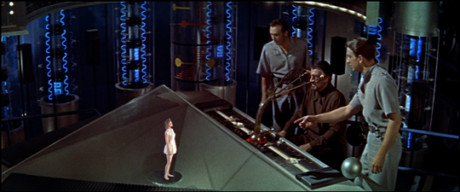
Today’s digital technology would be easily employed in carrying out the above process, what with the availability of such modeling software as Maya®, Autodesk®, Cinema 4D®, and others. However, back at the dawn of big-screen, science-fiction moviemaking the techniques used to visualize the 3-D description of Altaira (Ostrow’s “Aladdin’s lamp” analogy) was cumbersome and time-consuming in the extreme. “What you see on the screen, as far as the horizontal effect, is only a bare outline of what we could have done,” grieved draftsman Bob Kinoshita in the 1979 Cinéfantastique article. “It was very frustrating.”
Morbius nonchalantly invites the officers to take the Krell test of their intelligence. Of course, the men have no idea that Morbius’ own intellectual capacity has been doubled as a result of his taking the test a second time (his first attempt knocked him out for a day and a night). Doc is surprised that he is unable to raise the machine’s indicator above the halfway mark, despite his relatively high IQ. Adams meets the same fate, to which Morbius inartfully observes that a “commanding officer doesn’t need brains, just a good loud voice.” When Adams endeavors to create an image, Morbius stops him dead in his tracks, insisting he’d never survive the ordeal.
Sensing their mistrust of his motives, Morbius changes tactics somewhat. He discloses that he has recently “turned up some rather puzzling indications that in those final days before their annihilation, the Krell had been applying their entire racial energies to a new project, one which they actually seemed to hope might somehow free them once and for all from any dependence on physical instrumentalities.” What this means is that they would no longer be reliant solely on their machines in seeking further knowledge of the universe.
To movie-goers of the 1950s, Morbius’ disclosure might have seemed as incredulous and earth-shattering as it sounded — maybe even more so. But in our time, with the arrival of Web-based systems and the daily usage of wireless products and myriad forms of satellite communication, it leaves modern-day audiences with the impression of quaintness, tedium and dull routine.
Morbius now draws their attention to the gauges, whose calibrations “are set in decimal series,” with ten times as many amperes as those preceding them; in other words, “the number ten raised almost literally to the power of infinity.” Seeing his visitors’ startled reaction to this bit of information, Morbius casually inquires if they’d like to see more of the Krell “wonders.” Silly question! Of course they would. Wouldn’t you? It’s what us kids, enamored in our youth of the marvels of good science fiction writing, looked forward to.
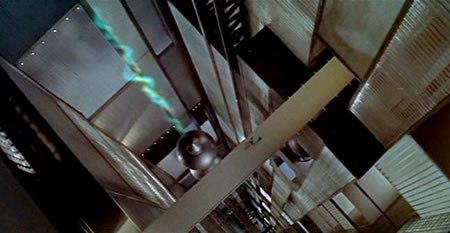
Planet (1956)
Stepping into a claustrophobic shuttle car with Adams and Ostrow, Morbius suggests they prepare their minds for a mind-boggling “new scale of physical scientific values.” He takes them on a guided tour of such breathtaking wonderment and unimaginable enormity that it must have impressed the hell out of George Lucas, Ridley Scott and Steven Spielberg, to name but a handful of the well-known future filmmakers, to new heights of science fiction fancy.
“A single machine, a cube 20 miles on each side,” he adds, emphasizing the opening and closing of nonstop circuitry, along with their immensely impressive ventilator shafts. Adams asks what the big machine’s intended use was. Morbius avoids a direct answer. Instead, he shows them a section of one of the power units, “the harnessed power of an exploding planetary system” — the face of the Gorgon, another reference to Greek mythology.
The enormity of the sets (mostly airbrushed matte paintings, cycloramas, double exposures onto miniatures and painstaking optical effects) and the dazzling display of gee-whiz gizmos, circuits and doodads, all tuned to Louis and Bebe Barron’s electronic tonalities must have left audiences aghast at the vastness of the proportions on CinemaScope’s wide-screen.
We cut to the men setting up and testing the force field around the perimeter of their base. Cookie approaches Lt. Farman. He’s itching to get out into the boondocks, in search of “wild radishes or something.” In truth, all he wants is to pick up his hooch, all 60 gallons of the stuff. In no time, Cookie gets smashed on the booze. “Genuine Kansas City bourbon!” he raves. Fortunately for him, Robby is standing close by.
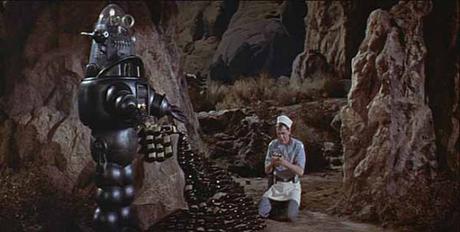
The Robot is alert to a presence nearby, but does not raise alarm bells. It’s the Id monster on the prowl, crossing the freshly activated force field. We can make out the blue outline of a massive form as it traverses the tractor beams. As the monster gets closer and closer to the space cruiser, it leaves some horrific footprints in the ground. Slinking up the gangplank and into the ship itself, the Id monster’s bulk makes the stair steps bend and groan under its weight.
Without warning, a deathlike scream is heard. Lt. Farman immediately reports in to the skipper that Chief Quinn has been murdered; his body splattered all over the communications area. (Yuck, shades of an interplanetary Jack the Ripper!)
Prior to Farman’s call, Adams had been arguing with Professor Morbius about his refusal to divulge any of the Krell’s secrets to the more “responsible” inhabitants of Earth. Morbius feels, as the keeper of the Krell flame, that “mankind is unfit to receive such knowledge, such almost limitless power,” which only he is capable of administering (in dribs and drabs, no doubt). He’s the watchdog, the self-appointed family retainer and the executor of what’s left of the Krell estate. Doc Ostrow sarcastically seconds Morbius’ claim. Only Morbius, with his “artificially expanded intellect … is ideally suited” to the task at hand. The irony of Doc’s crack is not lost on either Adams or Morbius. Indeed, the officers get no argument from Morbius. He is his own judge and jury, in that order.
Upon receiving the news of Quinn’s slaying, a dark shadow falls over Morbius’ features. At this stage in the plot, about the only thing the philologist can muster is a stifled “It’s started again,” a muted reference to the mass murder of his Bellerophon colleagues two decades prior.
Alta stands in the doorway, looking intently at her father. What must she be thinking! Is there any truth to the rumor that her lover, Commander John J. Adams, suspects dear ole dad of slaughtering his former shipmates?
(End of Part Two)
To be continued….
Copyright © 2017 by Josmar F. Lopes
Advertisements
